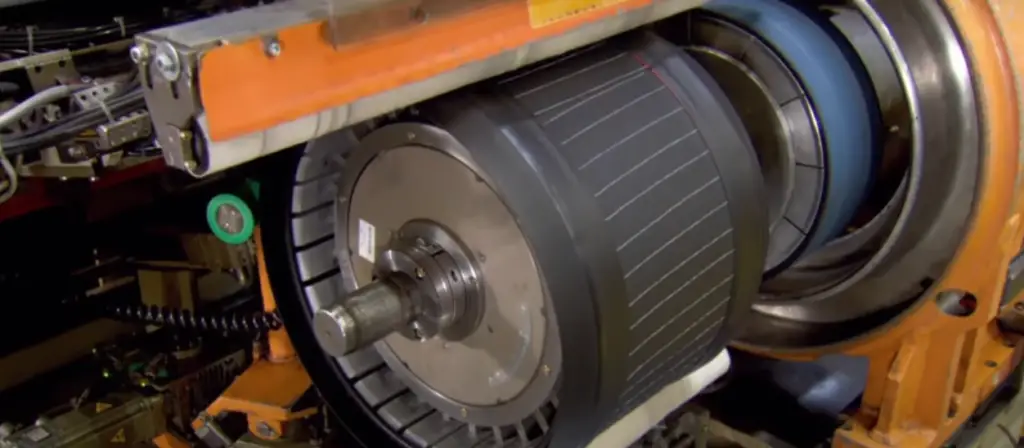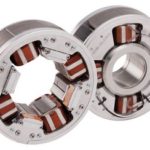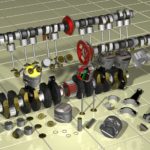Tires are inflated structures that act as a cushion to absorb shocks as they roll over different surfaces. Tires are designed according to the specifications of different vehicles, keeping in mind the bearing strength needed as it rolls over various surfaces. The bearing pressure needs careful consideration to not deform the tires surface excessively.
Materials
Pneumatic tires are manufactured using synthetic and natural rubber, fabric, wire, carbon black and other chemical components for strengthening the structure. There are two main parts, tread, and the body. The tread is responsible for traction while the body contains the compressed air and acts as a cushion.
A car tire is made in a tire forming machine that wraps multiple layers of different types of rubber around a metal wheel. Skilled assemblers along with the tire machine are responsible for assembling of different parts of the tires.
The Manufacturing Process

Mixing of Raw Material
The first step involves the mixing of raw materials like natural and synthetic rubber, Sulphur, carbon black and other components like oils and chemicals. Computer systems are fed with different recipes and can automatically measure out the ratio of ingredients for specific batches. Once the rubber is ready, it proceeds to the tire manufacturing machine.
Huge vertical mixers are used to mix the ingredients in batches up to 1100 pounds. The ingredients are then milled at high temperatures to soften them up and ensure proper mixing. At this stage, the mixture is again stirred and heat and friction are applied to further soften the mixture.
Tire Sheets
After the rubber has been thoroughly mixed it is passed through rolling mills to make thick sheets of the rubber. The body of the tire consists of sheets of fabric covered in rubber and is passed through a calendar machine.
These sheets are pretreated by manufacturers and adhesive are used to ensure good bonding with rubber sheets. The rubber and fabric sheets are known as a slap or ply; car tires are 3-4 slaps while heavy vehicles have multiple-ply tires.
Beads of the Tire
This is a composite fixed loop that ties together the slaps and locks the tire over the wheel assembly with a firm grip. A wire wrapping machine is made use of for making wire bundles which are later wound into rings. These rings are again covered in sheets of hard rubber.
Their basic function is to provide strength to the tire. The circumference of the beads is crucial in tire manufacturing as it has to fit over the wheel component.
Also Read:
- How Jet Engine Works? Easiest Explanation Ever
- Types of Braking System in Automobile
- How Suspension System Works in Automobile?
The Tread
The sidewalls and tread of the tire are made by the processing of rubber in an extruder. The rubber batch is processed and heated, then comes out of a die plate to form the rubber that will make the treads. This process involves heating to make the appropriate shapes and then cooled on cooling strips to set the treads.
The final step is cutting to the appropriate length of the tread. The sidewall components are also made through an extruder. The extruder system has barrels and heads that are responsible for heating, mixing and pressurizing the rubber. The sidewall rubber has a plastic covering when it is rolled and is formed under pressure. The rubber sheets are made into thin strips and stored into flat cases also called books.
Inner Lining
This is the innermost layer and holds the pressurized air within the tire. It is made using a butyl rubber in a calendar machine. The gauge control is important for maintaining the pressure within the tire so it has to be flawless.
Building the Finished Product
All the processed raw materials are delivered to an assembler who is stationed at the tire building machine. The tire parts are all loaded onto the collapsible rotating drum located at the epicenter of the equipment.
The assembler first puts together the fabric-covered rubber plies around the body of the drum. The ends of these sheets are combined using glue. The beads are then added and the remaining layers of rubber plies cover the beads to lock everything together.
The next step involves the use of special power tools to form the edges of tire plies. Now the rubber layers and the sidewalls are glued together and this rough form is called a green tire. This is removed from the tire machine and proceeds for further curing.
Curing of the Tire
For the curing process, a large metal mold is used which is shaped like a clam. The clam opens into a bladder which is a flexible balloon. The green tire is placed onto the bladder and the mold closes while steam fills into the bladder inflating the tire structure. The empty tread is forced against the interior of the clamshell.
The green tire is heated to 280 degrees or more depending on the type of the tire. The curing time also depends on the finished product that is required.
Once the curing is done, the tire is cooled and proceeds to further testing. The inspection process of each tire involves thorough checks for tears, bubbles or voids in the tread. Visual and X-ray inspection is performed on the tires. The tires are fixed on metal wheels and inflated to check their spinning ability.
Larger tires that undergo extreme friction must have components in place to regulate pressure. This is critical to aircraft, especially during the landing process.
These types of airplane tires may be equipped with an OPR valve containing a rupture disc. The disc is installed within the tire assembly and ruptures if pressure within the tire is too great. Once ruptured, the tire will release enough gas to put the tire back within a safe pressure.
Older tires may not contain rupture discs, and many have been retrofitted with devices to ensure they comply with modern safety standards.
With the extremely efficient and streamlined process of tire manufacturing, it is a rare occurrence that a tire gets rejected. Once the tire is passed through inspection it is shipped to different warehouses for distribution and sale.
For a Better Understanding of How a tire is made? Watch the Video…
Conclusion
In this article, we have learned all the steps of how a tire is made? If you find this informative and useful then don’t forget to like and share it.
Resources:









